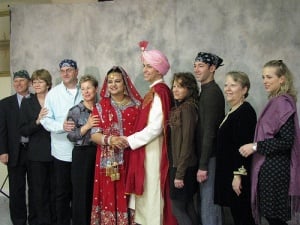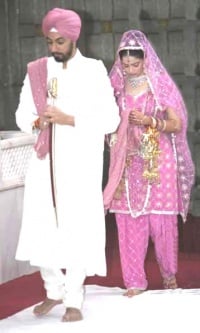The Sikh wedding ceremony is known as “Anand Karaj” which means ‘Blissful Union”. The marriage is a very colourful and unique ceremony in which two individuals are joined in a partnership of two equals.
It is not merely a physical and legal contract but a sacrament – a holy union between two souls. The spiritual goal of any Sikh is to merge his or her soul (atma) with God (Parmatma) and in marriage, the couple vow to help each other towards this goal.
The early part of the day is devoted to the religious ceremony which almost always takes place in a Sikh Gurdwara (Sikh temple).
What to wear
Photo showing traditional dress normally worn by Sikh couple at the “Anand Karaj” ceremony
Photo altair mahmud
If you’re invited to the formal religious ceremony and you are unable to wear a salwar kameez or sari or ethnic clothes, then bear the following in mind.
At most Sikh weddings the men will wear a western suit usually in dark colour like blue, brown, grey, some might even choose to wear a lighter colour such as lime, beige, etc. Some men will wear traditional Punjabi or ethnic clothing. Most women will wear traditional Punjabi dress in bright colours the preferred being blue, orange, brown, green, multi-colours, pink, etc.
Dress sense
- Modest dress is the order of the day; bare shoulders, plunging necklines and short skirts will be out of place at a religious venue but will be fine for the reception which normally does not take place in the Gurdwara. Some ladies prefer to take a shawl that they can throw over their shoulders, and wear pants to the Gurdwara and then wear a skirt to the reception. That way your outfit is acceptable at both venues.
- For the religious part of the ceremony, you will need to sit on the carpeted floor. You will be expected to sit cross-legged or otherwise on the floor for at least 45 minutes and this will prove difficult in tight or short clothing, so dress accordingly.
Colours to wear It is a tradition in Sikh culture to wear vibrant and joyous colours to such occasions. You will witness bright reds, radiant blues, deep green and a huge mixture of these and others colours among the ladies. Although, it is better to avoid pure white and black at the actual religious ceremony there is nothing sacrosanct, but you may feel a little out of place in some situations. It is easier for men – they may get away with a black suit at the religious ceremony. Dark colours for men may be OK.
Bright colours are certainly considered most auspicious at Asian weddings functions; pastels are also acceptable, especially in the summer. Try not to wear bright red as this is traditionally reserved for the bride and you wouldn’t want to outshine her on her special day!
The Bride & Groom
The bride is dressed in traditional shalwar and kameez or langa (a blouse and loose trousers or long skirt). A heavy gold-embroidered shawl (chunni or dupatta) covers her head. The groom is generally dressed in traditional shirt and trousers and he wears a red or dark pink turban and carries a coloured scarf (pulla).
In the Gurdwara

Photo showing non-Sikhs dressed to attend a Sikh wedding ceremony
Covering the head
At a Sikh wedding you will be require to cover your head when you are in the Gurdwara (temple). Carry a long scarf or a pashmina stole, which can also be used to cover up bare shoulders or arms, if necessary. Men usually wear the head covering provided at the temple or carry a large white or coloured handkerchief to place over their head.
Removing shoes
Also at the religious places you will be required to take off your shoes and place them in the designated space before you enter the sanctified area. While some places may require you to be barefooted, usually wearing socks or stockings is acceptable.
However, it is possible to attend just the formal religious wedding itself or just the lunch and gathering in the afternoon. Check with the host to clarify the exact programme.
The Wedding day protocol
The day usually starts early for the “Barat” which is the term used for the Groom’s side or the party of people accompanying the Groom.
Arrival at Gurdwara
- 1. Departure of Barat: (Barat is “the Grooms side”) The Barat will leave from the Groom’s house to go to the Gurdwara usually near the Bride’s house, where the actual wedding will take place. The arrangements for the rest of the day are normally made entirely by the Bride’s family. However, some of this is now changing.
If the groom lives far from the bride’s house, the Barat may depart early in the morning. It is common for the Barat to set off from the groom’s house at 8am. The Barat will then travel to the local area where the bride lives.
- 2. Reception of Barat: The Groom’s party is “received” by the Bride’s party at the Gurdwara. This usually takes place at about 9.30am.
- 3. Milnea: (means “Introductions”) The Ardas will be performed by the priest (Giani) followed by the formal introductions of the families. This will include the bride’s & groom’s father, grandfather and Mama – (mother’s brother). They will formally meet, exchange garlands (and gifts) and have their photographs taken. This normally takes place in the foyer area of the Gurdwara at about 10am.
- 4. Tea: Tea with savouries (normally samosa, pakoras) and sweets (generally jalebis, ladoos and barfi) will be served and are normally taken standing at tables in the Langar hall at the Sikh temple (Gurdwara). Chairs are seldom provided in the Gurdwara unless the person is elderly or otherwise unable to stand for any length of time. Both the Groom’s side and Bride’s sides will take tea in turn and this should be concluded at about 10.30am.
Main Ceremony
- 5. Main Wedding Ceremony (Anand Karaj)

The Couple slowing walking clockwise around the Guru Granth Sahib
- This is the formal part of the ceremony which always takes place in a Gurdwara. After tea, by about 11am, everyone proceeds into the Darbar sahib or main prayer hall. Please observe the rules applicable which are described at Visiting a Gurdwara. Also described here is the type of clothing that should be worn.
- Please note that you will be required to remove your shoes and cover your head in an appropriate manner before entering the main hall. Proceed into the darbar sahib paying attention to and observing the etiquette appropriate in the Darbar Hall. Always show respect to the Guru Granth Sahib as the Guru is held in high esteem by the Sikhs.
- Once in the main hall, you will be expected to sit on the carpeted floor for at least 45 minutes. It is essential that suitable clothing be worn. The formal part of the wedding ceremony normally starts at about 11am and ends at about 1pm and comprises of the following functions:
- a. Kirtan – The singing of the Holy Hymns – Gurbani. As you enter the darbar hall, musical singing of sacred hymns from the holy scriptures will already be taking place. The Kirtaini jatha (religious singers) will be seated on a stage in front of the hall next to the central stage of the Guru. The Guru Granth Sahib will be attended by a Sewadar (volunteer Sikh) or Giani (priest) who will be waving a Chaur over the Guru. After several Shabads (hymns) have been sang, the priest (Giani) or the stage secretary will announce the timetable for the formal part of the Anand Karaj ceremony in the darbar hall.
- b. Ardas – Key People (Bride, groom, both parents of bride and groom) will stand straight with folded hands and join in this prayer.
- c. Palla – The bride’s father will formally hand the end of the sash, which the bridegroom wears over his shoulder into the hands of the bride. At the same time the shabad “Palla tanda lagee” is sung by the Kirtania jatha (musicians).
- c. Laava – The Bride and Groom will walk in tow around the SGGS four times at the set intervals. First the priest will read a Laav (one of four) from the Guru Granth Sahib; then the musicians will sing the same laav while the Bride and Groom will circle the Guru in a clockwise direction.
- d. Ardas – All the congregation will stand and join in the ardas followed by Hukamnama.
- e. Sagaan – The parents of the Bride and Groom, followed by key people and the congregation will bless the newly wedded and give gifts or money and have photos taken.
- f. Kara Parshad – Blessed “Sweet pudding” is served. This ends the formal part of the Sikh wedding ceremony.
The wedding party and closing
- 6. Lunch: Previously this used to be Langar at the Gurdwara but now it is lunch at a commercial venue. When held in a commercial venue, it is like a normal “dinner & dance” type of event. Loud “Bhangra” music is played and, perhaps, even alcohol and meat may be served!
- 7. Departure of Doli: The bride changes into new clothes that are presented to her by the groom’s family. She then departs from her parent’s house (a very sad and touching occasion).
- 8. Reception: (Optional) This may be held on the same day or on another day and is an evening “dinner and dance” type occasion, sometimes not too formal (please check with the party) where only invited guests from both familes can attend.
